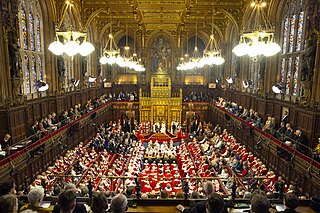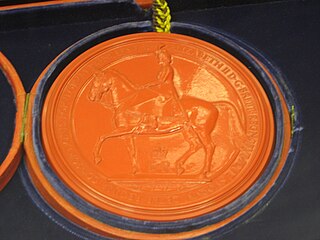This article needs additional citations for verification .(March 2008) |

Most Gracious Majesty is a form of address in the United Kingdom. It is an elaborate version of Your Majesty and is only used in the most formal of occasions.[ when? ]
This article needs additional citations for verification .(March 2008) |

Most Gracious Majesty is a form of address in the United Kingdom. It is an elaborate version of Your Majesty and is only used in the most formal of occasions.[ when? ]
Around 1519 King Henry VIII decided Majesty should become the style of the sovereign of England. "Majesty", however, was not used exclusively; it arbitrarily alternated with both "Highness" and "Grace", even in official documents. For example, one legal judgment issued by Henry VIII uses all three indiscriminately; Article 15 begins with "the Kinges Highness hath ordered," Article 16 with "the Kinges Majestie" and Article 17 with "the Kinges Grace."
In pre-Union Scotland, sovereigns were only addressed as Your Grace.
During the reign of James VI of Scotland and I of England and Ireland, however, James made Majesty the official title, to the exclusion of others.
The style "His/Her Most Excellent Majesty" is used solely for a present or past reigning monarch. The style "Her Most Gracious Majesty" may be used for a queen consort, queen mother, or dowager queen, in addition to a present or past reigning monarch.
In 2012, the Speaker of the House of Commons and Lord Speaker used a modified version of this style, addressing Queen Elizabeth II as 'Most Gracious Sovereign'. [1] [2]

His Majesty's Most Honourable Privy Council is a formal body of advisers to the sovereign of the United Kingdom. Its members, known as privy counsellors, are mainly senior politicians who are current or former members of either the House of Commons or the House of Lords.
Styles represent the fashion by which monarchs and noblemen are properly addressed. Throughout history, many different styles were used, with little standardization. This page will detail the various styles used by royalty and nobility in Europe, in the final form arrived at in the nineteenth century.

The monarchy of the United Kingdom, commonly referred to as the British monarchy, is the form of government used by the United Kingdom by which a hereditary monarch reigns as the head of state, with their powers regulated by the British Constitution. The term may also refer to the role of the royal family within the UK's broader political structure. The current monarch is King Charles III, who ascended the throne on 8 September 2022, upon the death of his mother, Queen Elizabeth II.
A style of office or form of address, also called manner of address, is an official or legally recognized form of address for a person or other entity, and may often be used in conjunction with a personal title. A style, by tradition or law, precedes a reference to a person who holds a post or political office, and is sometimes used to refer to the office itself. An honorific can also be awarded to an individual in a personal capacity. Such styles are particularly associated with monarchies, where they may be used by a wife of an office holder or of a prince of the blood, for the duration of their marriage. They are also almost universally used for presidents in republics and in many countries for members of legislative bodies, higher-ranking judges, and senior constitutional office holders. Leading religious figures also have styles.

A speech from the throne, or throne speech, is an event in certain monarchies in which the reigning sovereign, or their representative, reads a prepared speech to members of the nation's legislature when a session is opened. The address sets forth the government's priorities for its legislative agenda, for which the cooperation of the legislature is sought. The speech is often accompanied by formal ceremony. It is often held annually, although in some places it may occur more or less frequently, whenever a new session of the legislature is opened.
Defender of the Faith is a phrase that has been used as part of the full style of many English, Scottish, and later British monarchs since the early 16th century. It has also been used by some other monarchs and heads of state.
The style and title of the Canadian sovereign is the formal mode of address of the monarch of Canada. The form is based on those that were inherited from the United Kingdom and France, used in the colonies to refer to the reigning monarch in Europe. As various Canadian territories changed ownership and then the country gradually gained independence, the style and title of the monarchs changed almost as often as the kings and queens themselves. The mode of address currently employed is a combination of a style that originates in the early 17th century and a title established by Canadian law in 2024.

The State Opening of Parliament is a ceremonial event which formally marks the beginning of each session of the Parliament of the United Kingdom. At its core is His Majesty's "gracious speech from the throne", which is read by the monarch but written by HM Government. In the speech the monarch gives notice of forthcoming state visits, before setting out the government's legislative programme for the new parliamentary session. No business of either House of Parliament can proceed until the Sovereign’s speech has been delivered.
Royal Highness is a style used to address or refer to some members of royal families, usually princes or princesses. Kings and their female consorts, as well as queens regnant, are usually styled Majesty.

The use of the title of Princess of the United Kingdom of Great Britain and Northern Ireland is entirely at the will of the sovereign, and is now expressed in letters patent. Individuals holding the title of princess are styled "Her Royal Highness" (HRH). The current letters patent were issued in 1917 during the First World War, with one extension in 2012.

The Great Seal of the Realm is a seal that is used to symbolise the sovereign's approval of state documents. It is also known as the Great Seal of the United Kingdom. To make it, sealing wax is melted in a metal mould or matrix and impressed into a wax figure that is attached by cord or ribbon to documents that the monarch wishes to seal officially. The formal keeper of the seal is the Lord High Chancellor of Great Britain.

Succession to the British throne is determined by descent, sex, legitimacy, and religion. Under common law, the Crown is inherited by a sovereign's children or by a childless sovereign's nearest collateral line. The Bill of Rights 1689 and the Act of Settlement 1701 restrict succession to the throne to the legitimate Protestant descendants of Sophia of Hanover who are in "communion with the Church of England". Spouses of Catholics were disqualified from 1689 until the law was amended in 2015. Protestant descendants of those excluded for being Roman Catholics are eligible.
The precise style of the British sovereign has varied over the years. It is chosen and officially proclaimed by the sovereign. In 2022, King Charles III was proclaimed by the Privy Council to have acceded to the throne with the style:
Charles the Third, by the Grace of God of the United Kingdom of Great Britain and Northern Ireland and of His other Realms and Territories King, Head of the Commonwealth, Defender of the Faith

His/Her Serene Highness is a style used today by the reigning families of Liechtenstein, Monaco and Thailand. Over the past 400 years, it has also used as a style for senior members of the family of Hazrat Ishaan, who are believed to succeed Prophet Muhammad based on the 1400 year old Sunni Sayyid ul Sadatiyya line of Imamate of Ahlul Bayt. Until 1918, it was also associated with the princely titles of members of some German ruling and mediatised dynasties and with a few princely but non-ruling families. It was also the form of address used for cadet members of the dynasties of France, Italy, Russia and Ernestine Saxony, under their monarchies. Additionally, the treatment was granted for some, but not all, princely yet non-reigning families of Bohemia, Hungary, Italy, Poland, Romania and Russia by emperors or popes. In a handful of rare cases, it was employed by non-royal rulers in viceregal or even republican contexts.
Majesty is used as a manner of address by many monarchs, usually kings or queens. Where used, the style outranks the style of (Imperial/Royal) Highness, but is inferior to the style of Imperial Majesty. It has cognates in many other languages, especially of Europe.
His Grace and Her Grace are English styles of address used with high rank personages, and was the style used to address English monarchs until Henry VIII, and for addressing Scottish monarchs until the Act of Union of 1707, which united the Kingdom of Scotland and the Kingdom of England.
Highness is a formal style used to address or refer to certain members of a reigning or formerly reigning dynasty. It is typically used with a possessive adjective: "His Highness", "Her Highness" (HH), "Their Highnesses", etc. Although often combined with other adjectives of honour indicating rank, such as "Imperial", "Royal" or "Serene", it may be used alone.
The precise style of French sovereigns varied over the years. Currently, there is no French sovereign; three distinct traditions exist, each claiming different forms of title.
Most Excellent Majesty is a form of address in the United Kingdom. It is mainly used in Acts of Parliament, where the phrase "the King's [Queen's] most Excellent Majesty" is used in the enacting clause.

The Lord High Admiral of the United Kingdom is the ceremonial head of the Royal Navy. Most have been courtiers or members of the British royal family, and not professional naval officers. The Lord High Admiral is one of the nine English Great Officers of State and since 2021 is held personally by the reigning monarch.